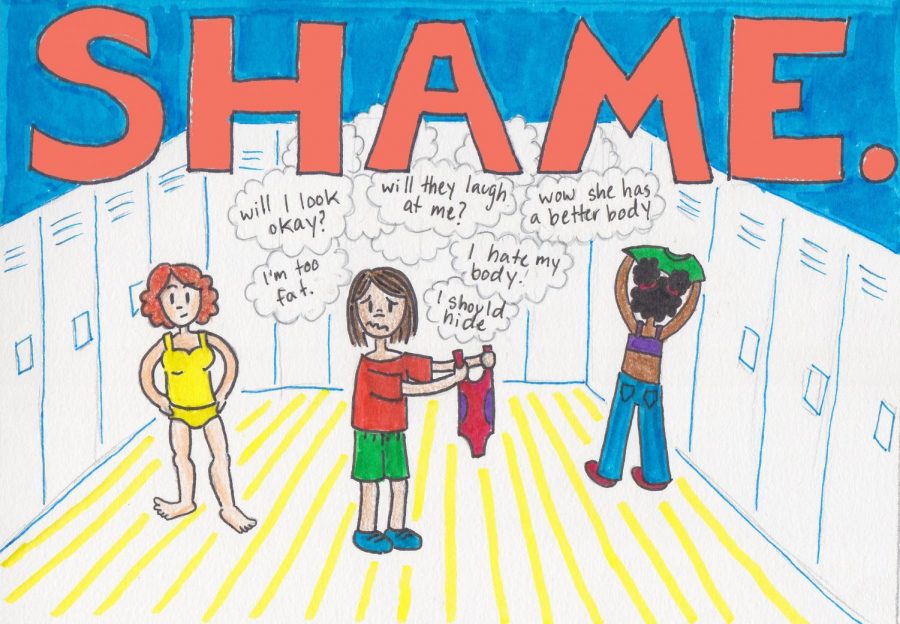P.E. causes students to feel unsafe during swimming
November 12, 2018
While Physical Education remains a mandated course, certain aspects can cause anxiety and feelings of unsafety for students.
“I appreciate enthusiasm, respect and kindness; however, participation is still the foundation of class,” freshman P.E. teacher Tracy Morel says.
Swimming in Relation to Body Shaming
First off, form-fitting swimsuits draw attention to the issue of body-shaming. The tight swimsuits and being forced to change in front of classmates, with little to no privacy, can cause extreme feelings of unsafety for students, especially considering unrealistic beauty standards regarding body types.
During my completion of the swim unit freshman year, I personally felt uncomfortable being so exposed with such a lack of privacy. As I’ve observed in the locker room, my classmates attempt to cover up as much as possible when changing, but it can be extremely difficult because we are only given a single hand-towel.
“I don’t like changing in the locker room because you have to maneuver the little towel to cover your entire body,” sophomore Catie Glascott says.
In addition, the stalls in the rear of the locker room are often occupied, leaving no choice but to change in the locker rows.
However, “Students can wear shorts or a shirt over or under their swimsuits, and there’s a few private stalls in the locker room,” Morel says.
Swimming in Relation to Religion
Another problem with conventional swimsuits is they don’t meet certain religious requirements. Some students are unable to wear the curriculum-required one-pieces, which can lead to a feeling of separation from the class, as well as feeling excluded from the unit as a whole.
“I have to wear clothes that cover my body and are loose, and a swimsuit does the opposite,” sophomore Laiba Idrees says. “I had to switch to a completely different class in the middle of the year and the classmates already knew each other and had built friendships with each other. I had to be the new kid and it was awkward.”
For students like Idrees, P.E. classes cause a feeling of exclusion from their peers based on their religious-related practices.
Swimming in Relation to Race
The swim unit can also emphasize differences in socio-economic backgrounds among students. Because some students have had previous experiences with swim lessons or frequent access to a lake, they’ll likely be tracked into a higher level in the swim unit. These advantages often link directly to coming from a richer background and being white, which can lead to a feeling of separation among students who are different on the dimensions of race and household finances.
Historically in the United States, slaves who could swim were seen as large threats because swimming was viewed as an escape route. In response, slave owners meticulously kept an eye on those who could swim and endeavored to prevent any access their slaves may have to water. This resulted in many black individuals lacking or not learning the ability to swim, post-slavery.
Furthermore, a 2015 article from The Washington Post offers a jarring history of race in relation to swimming. The earliest swimming pools date back to the early 1900s and served males of all races. However, pools in the North quickly became segregated once the wealthier white men decided they didn’t want to be accompanied by working-class citizens in their place of recreation. Public swimming pools in the South in the 1920s and 30s contrasted greatly, blatantly posting “whites-only” signs. As a result, many black people couldn’t learn to swim because they lacked access to pools well into the 1900s.
This led to a generation of black children who couldn’t swim because their parents never learned. A study conducted by USA Swimming found that 70 percent of African-American children said they had little to no ability to swim, while only 42 percent of white children didn’t know how to swim. In effect, P.E. classes uphold the inequalities that exist for minority groups such as African Americans.
Swimming in Relation to Economics
As for the different economic backgrounds of students, data collected by Federal Reserve last year showed that white families have a median net worth of over $150,000, and “Black and Hispanic families have conisderably less wealth” — less than 15 percent that of white families, according to a Federal Reserve System note on “Recent Trends in Wealth-Holding by Race and Ethnicity: Evidence from the Survey of Consumer Finances.” These inequalities become more visible when examining extracurricular experiences like swimming classes.
Consider Goldfish Swim School, right here in Evanston. Lessons for children ages 4-12 range from $88-$440/month. These expensive prices are simply out of reach for many poor and working class households.
In Conclusion
The current version of the swim unit as maintained through ETHS’s P.E. department needs to be reevaluated to respond to the culture of body shaming, infringement on specific religious beliefs and the history of racism and classism in this country.










Judel Vilus • Dec 14, 2018 at 3:29 pm
I THINK THE WORLD IS TOO SENSITIVE.
Swimming in schools has been around for decades especially at ETHS. Removing it and/or reevalutating it will cause students to feel more safer but then will not to teach the student to get thicker skin so they dont feel as bad.